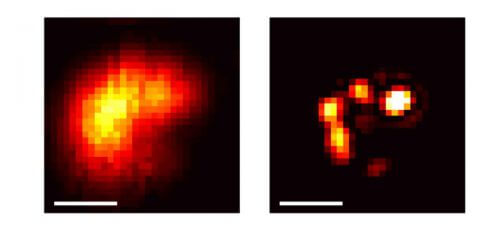Is it possible to cross Ernst Abbe's limit of resolution by using the quantum properties of light?

Much more detail: nanocrystals as they are seen using the microscopy method developed by scientists at the Weizmann Institute of Science (right) and as they are seen under a normal light microscope (left). Scale: 0.5 micron
Everything has a limit. For example, Ernst Abbe discovered, in 1873, that there is a limit to the resolution, the ability to separate objects that can be observed using a light microscope - even if we polish the microscope lenses optimally. The physicist, who later was the partner of Carl Zeiss, and was even the owner and manager of the well-known lens factory bearing Zeiss's name (ZEISS), applied Maxwell's equations to the light microscope, thus discovering the limit and the reason why we cannot cross it.
"Ava's limit" was determined, in fact, as a result of the range limit of the length of the light waves that the human eye perceives: 390-750 nanometers. Abe showed and explained why the smallest object, which can be observed using the most sophisticated light microscope we can build, is half the wavelength of visible light: 200 nanometers.
60 years passed until Ernst Roska, and his supervisor, Max Knoll, developed - in 1933 - the first electron microscope, which used an electron beam instead of visible light. Since the electron's wavelength is significantly shorter than the smallest wavelength of visible light, it is possible to observe objects 2,000 times smaller than those that can be seen in a light microscope - but for this the observed sample must be fixed, which does not allow observing living systems.
From the right: Uri Rossman, Bat El Raphael, Prof. Dan Oron and Dr. Ron Tana. Scientists always strive to see in more detail
Almost another 70 years passed, until in 1999 Stefan Hell introduced a new type of light microscope, which he named STED (acronym for Stimulated Emission Depletion), which allows breaking the limit of Abe's resolution. This microscope is based on a single laser beam that excites an electron in the molecule of the observed substance. Most of the time, the excitation energy is released by the emission of a photon - a light particle - in a process called fluorescence. But, in Hell's innovative microscope, an additional laser beam is sent towards the sample, which turns off the fluorescence and limits it to a very small area in the sample. By scanning these rays over the sample being examined, it is possible to observe objects with the size of a few nanometers, even when it comes to proteins that are found and operate within a biological system. A few years later, Eric Betzig introduced an alternative method for resolution that passes the limit introduced by Abe, PALM (acronym for Photoactivated light microscopy). This method is based on light-emitting molecules that can be activated by light. The development of these methods, each of which is based on breaking one of the fundamental assumptions of Ebba's model, earned Stefan Hell and Eric Betzig, together with William Marner, the 2014 Nobel Prize in Chemistry.
Prof. Yaron Zilberberg
But, as we know, scientists always strive to see in more detail, smaller, more distant objects, or faster processes. Prof. Yaron Zilberberg and Prof. Dan Oron and their research partners from the Department of Physics of Complex Systems at the Weizmann Institute of Science tried to find a way to cross Abba's limit using the quantum properties of light (Abba assumed, of course, in his model, classical physics, since quantum theory was only developed a few decades later). The Institute's scientists used the quantum property that characterizes light-emitting markers, according to which any molecule or nanometer particle that is stimulated, for example by means of a laser beam, can emit one and only one photon (that is, they cannot emit two or more photons at the same time). To this end, the scientists asked to "photograph" the photon emission, but it is a very fast process, and even a camera that takes 1,500 photos per second is not able to distinguish it.
Because of this, they replaced the camera with an array of fast detectors sensitive to the emission of a single photon and mounted it on a scanning optical microscope (based on the confocal microscope invented by Marvin Minsky in 1957). According to calculations, the combination of these systems may allow scientists to cross the limit of Abba and see objects up to four times smaller than those that can be seen with a normal light microscope. In the experiment they carried out - in such an integrated system - the scientists of the institute managed to cross the limit of Ava and actually observe objects two and a half times smaller than the size defined by this limit. Tuning and experience may allow them to realize the results of the calculation - and observe objects four times smaller.
The peak resolution in optical microscopy is about 6 nanometers, 1 divided by 100 of the wavelength of the light in the experiment. The record was reached in 2009 using the STED method.
